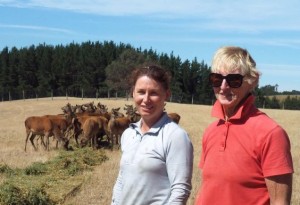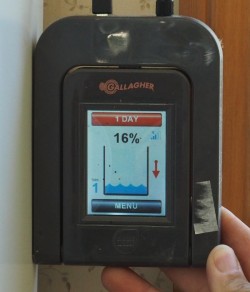Feb 16, 2024
The current non-typical El Ninõ weather pattern has revealed the sting in its tail. According to the NIWA drought monitor, much of Marlborough and parts of northern North Canterbury are now in drought. It is also extremely dry across the south of the North Island, inland South Canterbury and Central Otago.

Wairau Valley deer farmers Giselle and Marilyn Shewan. They prepared well for the drought, but the lack of killing space for their cull velvetting stags has been frustrating.
DINZ visited three Marlborough deer farmers in late January to see how they were coping with the severe dry. They were relatively positive. Marlborough is known for its droughts, so all three were well prepared with good feed reserves.
Each of them start feeding early in the dry, so their pastures are not hammered by over-grazing but, if the drought lasts long enough, some paddocks have to be sacrificed. Even where deer have unlimited access to conserved feed, they will still nibble on what’s left of the grass until it’s all gone.
Target liveweights for finishing stock need to be sacrificed too ... the farmers say it’s essential to quit finishers early. The focus needs to be on keeping replacements growing and improving hind condition in the run-up to mating.
Euan Rentoul, an industry veteran, says it’s crucial is to set goals and to respond as the season progresses.
“You might decide in advance that if it hasn’t rained by, say, 1 February, you’re going to drop something. If you are a breeder, quit hinds and adult animals before replacements. Because you are limited in what you can do with deer – they can only be grazed in deer-fenced areas – it also makes sense to carry some stock, like store sheep, that can easily be dropped or grazed elsewhere.”
Upper Wairau Valley farmers Marilyn and Giselle Shewan say destocking is great, just so long as you can get killing space. They have been trying for months to get killing space for their cull velvet stags and ask why the processors don’t give priority to culls from drought-affected regions. With the roar approaching, they now face feeding old stags for no gain for another two or three months.
Justin Stevens of Seddon has one big take-home message for farmers entering a drought. “Have a plan for water. It’s vital. Deer can survive for quite a long time in a drought with very little feed, but they start going down after more than a day or two without water.”

Peace of mind – tank monitoring direct to your smartphone.
How much water do they need? Stevens says his 200 stags are drinking at least 3,000 litres a day. The official recommendation is to allow for 20 litres/stag/day.
For peace of mind, he suggests getting an electronic monitoring system to keep a track of tank water levels. For between $500 and $1,000, several tanks can be monitored via a smart phone.
The Rentouls have reticulated water to all paddocks, fed by two wells and two pumps. The system is designed so that if one pump or well goes down, the remaining pump can feed the whole system.
The Shewans usually physically check all their troughs every day during summer but during Christmas, when they had other things on their mind, Marilyn’s husband Jim checked all the troughs using a drone.
It’s proving to be a tough summer, with their farm looking increasingly like what daughter Giselle describes as “a desert”. But they haven’t lost their sense of humour. She has a strategy for encouraging rain. It’s quite simple – leave some hay outside, uncovered.
“Sacrificial hay left in the paddock has been proven, time after time, to bring on rain.”
For some drought management tips, check out the ‘Drought feeding and management’ Deer Fact >>

